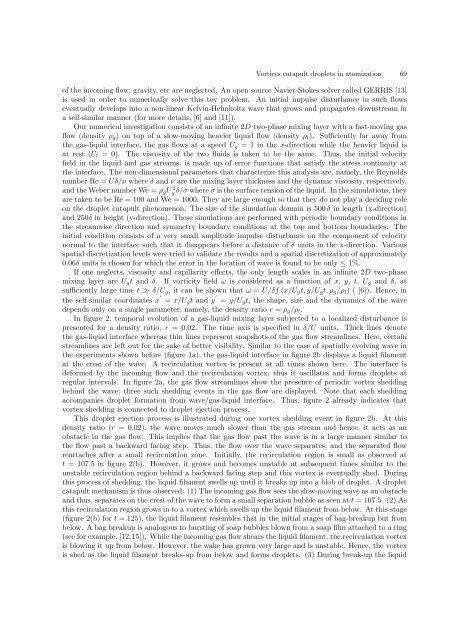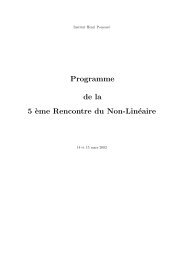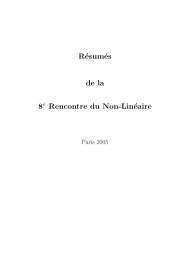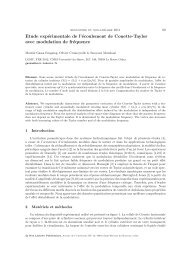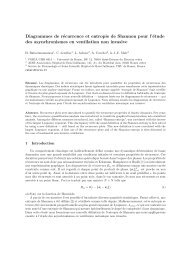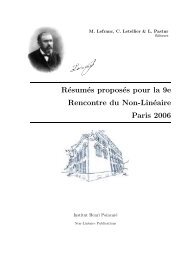Rencontre du Non-Linéaire
l'intégralité des comptes-rendus - science non linéaire
l'intégralité des comptes-rendus - science non linéaire
- No tags were found...
Create successful ePaper yourself
Turn your PDF publications into a flip-book with our unique Google optimized e-Paper software.
Vortices catapult droplets in atomization 69<br />
of the incoming flow, gravity, etc are neglected. An open source Navier-Stokes solver called GERRIS [13]<br />
is used in order to numerically solve this toy problem. An initial impulse disturbance in such flows<br />
eventually develops into a non-linear Kelvin-Helmholtz wave that grows and propagates downstream in<br />
a self-similar manner (for more details, [6] and [11]).<br />
Our numerical investigation consists of an infinite 2D two-phase mixing layer with a fast-moving gas<br />
flow (density ρ g ) on top of a slow-moving heavier liquid flow (density ρ l ). Sufficiently far away from<br />
the gas-liquid interface, the gas flows at a speed U g = 1 in the x-direction while the heavier liquid is<br />
at rest (U l = 0). The viscosity of the two fluids is taken to be the same. Thus, the initial velocity<br />
field in the liquid and gas streams, is made up of error functions that satisfy the stress continuity at<br />
the interface. The non-dimensional parameters that characterize this analysis are, namely, the Reynolds<br />
number Re = Uδ/ν where δ and ν are the mixing layer thickness and the dynamic viscosity, respectively,<br />
andtheWebernumberWe = ρ g Ug 2 δ/σ whereσ isthesurfacetensionoftheliquid. Inthesimulations,they<br />
are taken to be Re = 100 and We = 1000. They are large enough so that they do not play a deciding role<br />
on the droplet catapult phenomenon. The size of the simulation domain is 500δ in length (x-direction)<br />
and 250δ in height (y-direction). These simulations are performed with periodic boundary conditions in<br />
the streamwise direction and symmetry boundary conditions at the top and bottom boundaries. The<br />
initial condition consists of a very small amplitude impulse disturbance on the component of velocity<br />
normal to the interface such that it disappears before a distance of δ units in the x-direction. Various<br />
spatial discretization levels were tried to validate the results and a spatial discretization of approximately<br />
0.06δ units is chosen for which the error in the location of wave is found to be only ≤ 1%.<br />
If one neglects, viscosity and capillarity effects, the only length scales in an infinite 2D two-phase<br />
mixing layer are U g t and δ. If vorticity field ω is considered as a function of x, y, t, U g and δ, at<br />
sufficiently large time t ≫ δ/U g , it can be shown that ω = U/δf (x/U g t,y/U g t,ρ g /ρ l ) ( [6]). Hence, in<br />
the self-similar coordinates x ′ = x/U g t and y ′ = y/U g t, the shape, size and the dynamics of the wave<br />
depends only on a single parameter, namely, the density ratio r = ρ g /ρ l .<br />
In figure 2, temporal evolution of a gas-liquid mixing layer subjected to a localized disturbance is<br />
presented for a density ratio, r = 0.02. The time axis is specified in δ/U units. Thick lines denote<br />
the gas-liquid interface whereas thin lines represent snapshots of the gas flow streamlines. Here, certain<br />
streamlines are left out for the sake of better visibility. Similar to the case of spatially evolving wave in<br />
the experiments shown before (figure 1a), the gas-liquid interface in figure 2b displays a liquid filament<br />
at the crest of the wave. A recirculation vortex is present at all times shown here. The interface is<br />
deformed by the incoming flow and the recirculation vortex, thus it oscillates and forms droplets at<br />
regular intervals. In figure 2a, the gas flow streamlines show the presence of periodic vortex shedding<br />
behind the wave; three such shedding events in the gas flow are displayed. Note that each shedding<br />
accompanies droplet formation from wave/gas-liquid interface. Thus, figure 2 already indicates that<br />
vortex shedding is connected to droplet ejection process.<br />
This droplet ejection process is illustrated <strong>du</strong>ring one vortex shedding event in figure 2b. At this<br />
density ratio (r = 0.02), the wave moves much slower than the gas stream and hence, it acts as an<br />
obstacle in the gas flow. This implies that the gas flow past the wave is in a large manner similar to<br />
the flow past a backward facing step. Thus, the flow over the wave separates; and the separated flow<br />
reattaches after a small recirculation zone. Initially, the recirculation region is small as observed at<br />
t = 107.5 in figure 2(b). However, it grows and becomes unstable at subsequent times similar to the<br />
unstable recirculation region behind a backward facing step and this vortex is eventually shed. During<br />
this process of shedding, the liquid filament swells up until it breaks up into a blob of droplet. A droplet<br />
catapult mechanism is thus observed: (1) The incoming gas flow sees the slow-movingwaveas an obstacle<br />
and thus, separateson the crest of the wave to form a small separationbubble as seen at t = 107.5. (2) As<br />
this recirculation region grows in to a vortex which swells up the liquid filament from below. At this stage<br />
(figure 2(b) for t = 125), the liquid filament resembles that in the initial stages of bag-breakup but from<br />
below. A bag breakup is analogous to bursting of soap bubbles blown from a soap film attached to a ring<br />
(see for example, [12,15]). While the incoming gas flow shears the liquid filament, the recirculation vortex<br />
is blowing it up from below. However, the wake has grown very large and is unstable. Hence, the vortex<br />
is shed as the liquid filament breaks-up from below and forms droplets. (3) During break-up the liquid


